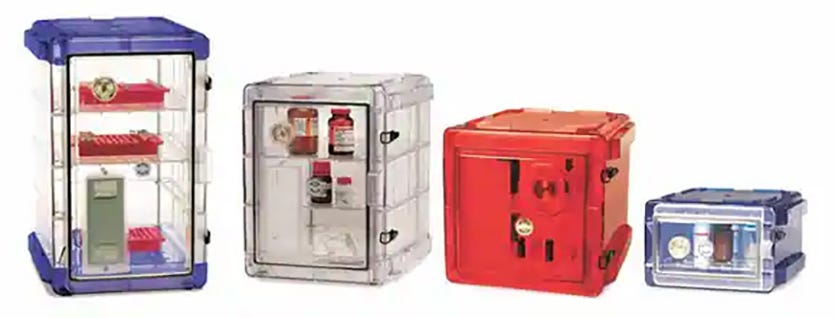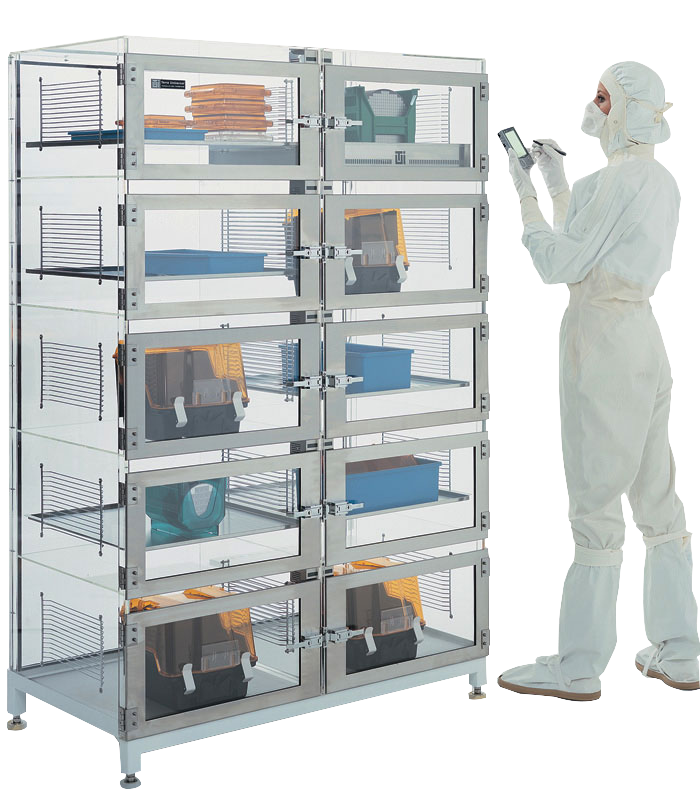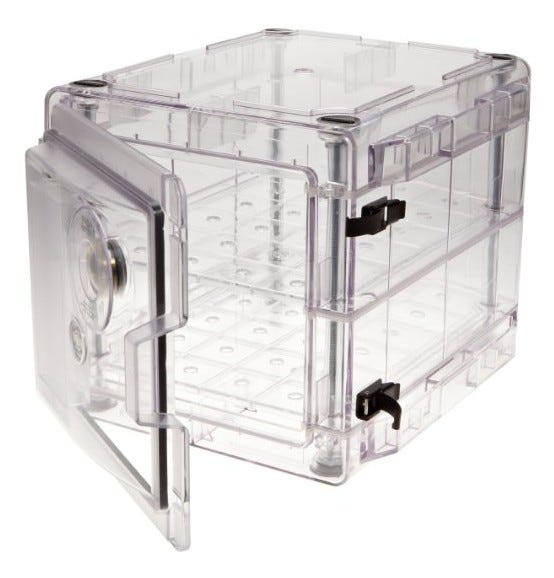- +1 (714) 578-6100
Hours Mon - Fri, 07:00 AM - 06:00 PM (Pacific Time)

Desiccator Selection Guide | Bel-Art Secador Desiccant Types
Posted:
August 08, 2022
Categories:
Desiccators
A desiccator, also referred to as a dry box or dry cabinet, is a humidity-controlled chamber that produces a dry, clean environment conducive to the storage of sensitive materials, samples, or components. A desiccator environment is ideal for storing oxidation-prone, hygroscopic, or moisture-sensitive substances such as forensic material, DNA samples, biological cultures, documents, electronic packages, and microelectronic components. Controlled dry storage is ideal in any case where moisture can accelerate microbial spoilage, chemical reactions, mold, and oxidation.
Desiccators are an economical and reliable way to assure dry, dust-free, and if necessary, air-free storage of humidity-sensitive products, such as valuable reagents or electronics. In recent decades, desiccators have become increasingly essential to prevent material degradation during high-volume throughput and storage of thermoplastics. Thermoplastics including PLA, Nylon, and PVA will actively absorb water from the air, thus desiccators make an excellent storage solution when swapping out filaments for multi-material prints
For manufacturing processes that require adhesives, moisture is a common contributor to the failure of surface-mounted parts. Excess moisture in the adhesive mixture can cause failure as a result of voids within the bond line due to desorption or entrapment.
What Are the Different Types of Desiccator Cabinets?
Use this chart for an overview of the environment and the benefits each method of desiccation provides.
| Standard Desiccant | Automated, Sstandard Desicant | Gas Purge | Vacuum |
| Manual monitoring and operation. Moisture is absorbed from air in the unit by using a desiccant. Once the desiccant is 'saturated' it must be regenerated through heating, or replaced. | Electric fans and heaters continuously regenerate the desiccant to prevent saturation and to automatically maintain a low humidity environment. | A slow steady flow of inert gas (often dry nitrogen) is provided. | Air and moisture are removed by the chamber by use of a vacuum pump. |
| Flexibility to use any type of desiccant (silica gel beads, activated charcoal, etc) based on economics and convenience. | Convenience, requires minimal monitoring. | Achieve relative humidity at a much faster rate. | Best for total dry storage or if air could be damaging to material being stored. |
| Portability. | Precise control of humidity. Operates on a set schedule of desiccation followed by a regeneration period. | Dust free and desirable for many applications including clean room environments. | Dust free and desirable for many applications including clean room environments. |
| Economical functionality. Most desiccants can be regenerated periodically. | Process uses silica gel beads that last for thousands of regeneration cycles. | Option to close stopcocks and use with regular desiccants. | Option to close stopcocks and use with regular desiccants. |
What is the Best Desiccator Cabinet for My Application?
The right desiccator for your environment largely depends on the part size, environmental conditions, and sensitivity of stored items. Depending upon what you are storing, optimal conditions can be achieved using standard desiccants in a manual or automated format, with gas purge, or by keeping the contents under vacuum.
Automated Desiccator Cabinets
An automated desiccator requires much less monitoring than silica desiccant or canisters. Actively powered desiccator cabinets use electricity for dehumidification and are typically capable of maintaining moisture levels down to 10% RH.
The downside of actively powered dry cabinets is that each time a door is opened, ambient air floods into the chamber, and humidity levels rise. Depending on the ambient temperature and humidity, it can be difficult to quickly achieve ideal drying conditions in humid climates.
Dry cabinets are typically able to reduce humidity levels by 20 - 40% RH compared to the ambient environment but experience longer cycle times to achieve. Therefore, hygroscopic materials, resins, and adhesives may experience unacceptable levels of humidity until the cabinet can achieve a target humidity level.
Nitrogen Purge Desiccator Cabinets

Nitrogen purge desiccators and dry cabinets can achieve much lower humidity levels than other technologies. Once the chamber is sealed, the chamber backfills with a nitrogen (N2) gas and purges ambient air. An N2 purge system can rapidly achieve ultra-low humidity levels under 1% RH. Gas ported desiccators are quick to achieve relative humidity, but if the unit is accessed frequently, proportionately more gas will be needed to keep the desired low humidity level.
Vacuum Drying
In some cases, a vacuum desiccator chamber alone may provide adequate humidity removal without requiring nitrogen or desiccants. Vacuum drying is ideal for components that would otherwise not be suitable for elevated temperatures during baking. As an added benefit, vacuum pressure allows water and solvents to evaporate at lower temperatures. Vacuum desiccators can be brought back to vacuum rather easily after opening but require a pump. Ideally, the vacuum chamber is supplied with pre-treated and dehumidified air, otherwise, the vacuum cycle may require frequent if not continuous vacuum cycles. A vacuum drying system is most effective when room air is less humid and the chamber does not require frequent access.
Silica Gel Cartridges and Canisters
Silica Gel Desiccant Drying Cartridges and Reusable Desiccant Canisters reduce moisture in desiccator cabinets and turn pink when maximum moisture is absorbed. The silica-gel desiccant is then oven-baked to remove moisture and reused. Silica-based desiccants are economical for dust-free enclosures inapt to specific humidity requirements.
What Are the Available Chamber Styles and Configurations for Bel-Art Secador Desiccator Products?
Once you have determined your most desirable method of desiccation, there are a variety of styles and sizes of desiccators to choose from. Terra provides numerous desiccator configurations that increase storage capacity while also reducing the footprint of storage devices.
Bel-Art Secador

For creating optimal dry, dust-free, and sometimes air-free storage of moisture-sensitive products, Secador® 1.0 and 2.0 desiccators are ideal for pharmaceutical, industrial, and electronic components packaging industries.
Secador's patented seal design provides excellent moisture protection, and the one latch loops allow securing with a lock or tamper-evident seal. A door-mounted hygrometer allows convenient tracking of RH. Manually operated and monitored models are made from Durastar® co-polyester plastic material that blocks 99% of UV light from penetrating the interior of the cabinet. These desiccators resist stains, chemicals, and fine cracks. Interchangeable units have built-in carrying handles and stack up to three units high. Moisture is absorbed inside the unit by silica, activated charcoal, and/or gel beads
Bel-Art Desiccator Styles and Configuration
Bel-Art Benchtop Desiccator Cabinets feature removable, tray-like shelves with perforated bottoms that slide in/out on pre-set rails.
Bel-Art Vacuum Space-Saver Desiccator Chambers include a clear, chemical-resistant polycarbonate base with interlocking ridges for stacks up to 3 units high. Space Saver Desiccators use either high-heat desiccator plates or desiccant cartridges to quickly dry samples or degas parts
Bel-Art Portable Vacuum Desiccators provide reliable and economical drying chambers for classrooms and research laboratories.
Vacuum Space-Saver desiccators use high-heat desiccator plates or desiccant cartridges to quickly dry samples or degas parts
Non-vacuum desiccators are feasible as a drying chamber for thin-layer chromatography plates, dried materials, and chemical standards.
Can I Use a Desiccator Cabinet to Bake or Actively Dry Materials?
Typically, a desiccator is appropriate for maintaining low levels of moisture, but not a meaningful replacement for removing moisture from already saturated items. A desiccator cabinet maintains dry conditions that prevent trace moisture from degrading sensitive parts from absorbing moisture during storage or assembly workflows.
Moisture is removed from the chamber product via silica desiccant, active drying, or purged via an inert gas or vacuum to prevent adsorption. Adsorption is the adhesion of atoms, ions or molecules which originate from a gas, liquid or dissolved solid to a surface.
Desiccant Packages for Secador Desiccant Cabinets
Desiccant drying packages are Ideal for use with Secador 1.0 or 2.0 desiccators, these desiccant cartridges reduce moisture and the silica gel beads turn pink when saturated with moisture. The transparent polystyrene dish allows silica gel examination without requiring access or opening of the chamber. Beneficially, the desiccant is non-toxic, non-corrosive and inert.
Where Can I Find Desiccators and Nitrogen Generation Systems Online for Bel-Art Desiccators?
Nitrogen Generator Systems for Bel-Art Desiccators
A nitrogen generation system is ideal for N2-based desiccators without requiring 3rd party vendors and constant replenishment of cylindrical tanks.
Bel-Art N2 desiccators are configurable with two systems:
To maintain RH levels as low as 7%, purchase nitrogen generator catalog number 2700-99
To maintain RH levels below 1%, purchase nitrogen generator catalog number 2700-12B
Learn More: Moisture Free Storage or Desiccants?
Where Can I Buy Secador Desiccators and Bel-Art Products Online?
Terra Universal is a factory-direct, authorized dealer of Bel-Art Secador products and also provides a wide selection of desiccators with materials and unparalleled accessories catered for your application.
Shop nitrogen purge, benchtop, and portable desiccators online at Terra Universal, or chat with a live product specialist to discuss your unique requirements.
Terra Universal is the leading expert in the design and fabrication of ISO rated cleanrooms, furnishing and supplies.
Get a free consultation from one of our cleanroom specialists:
Call (714) 459-0731


